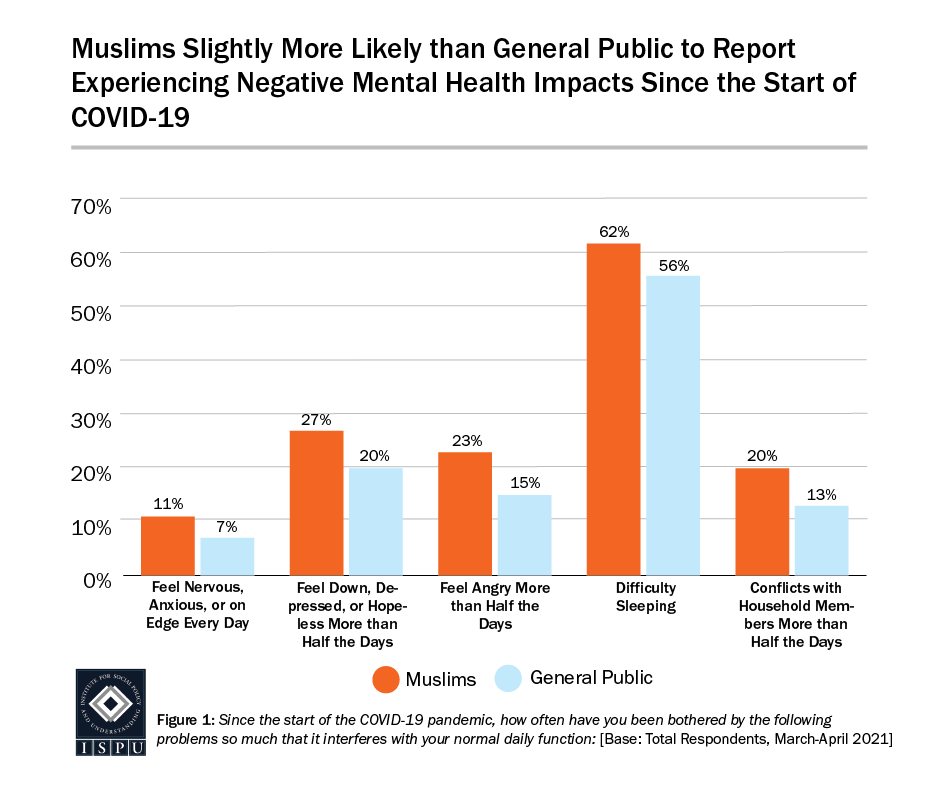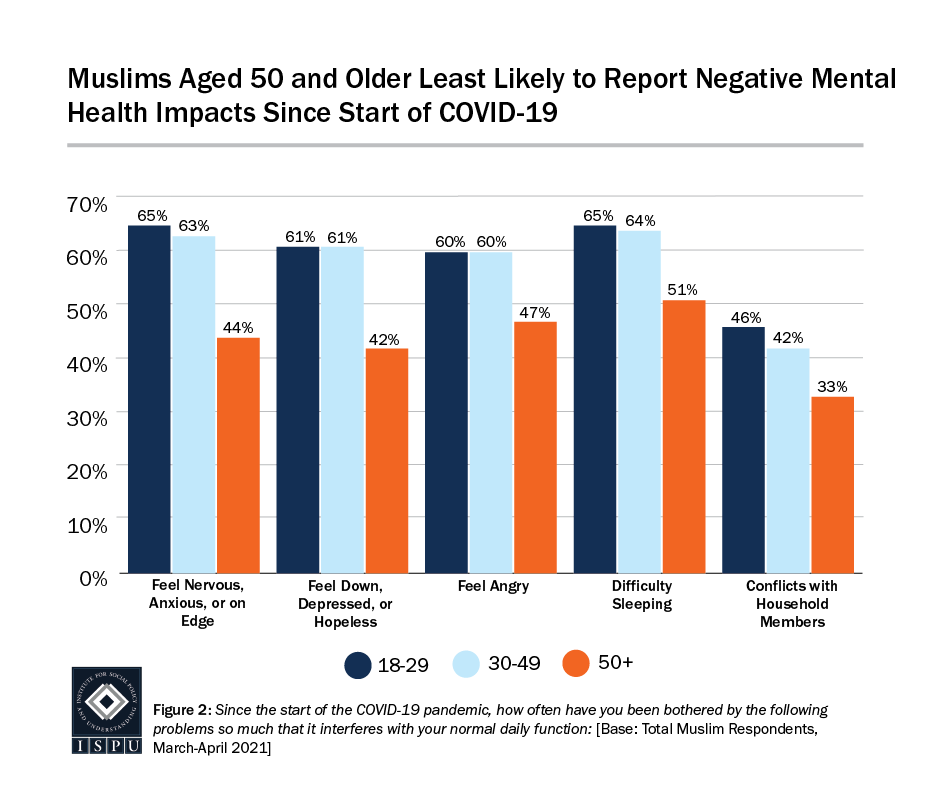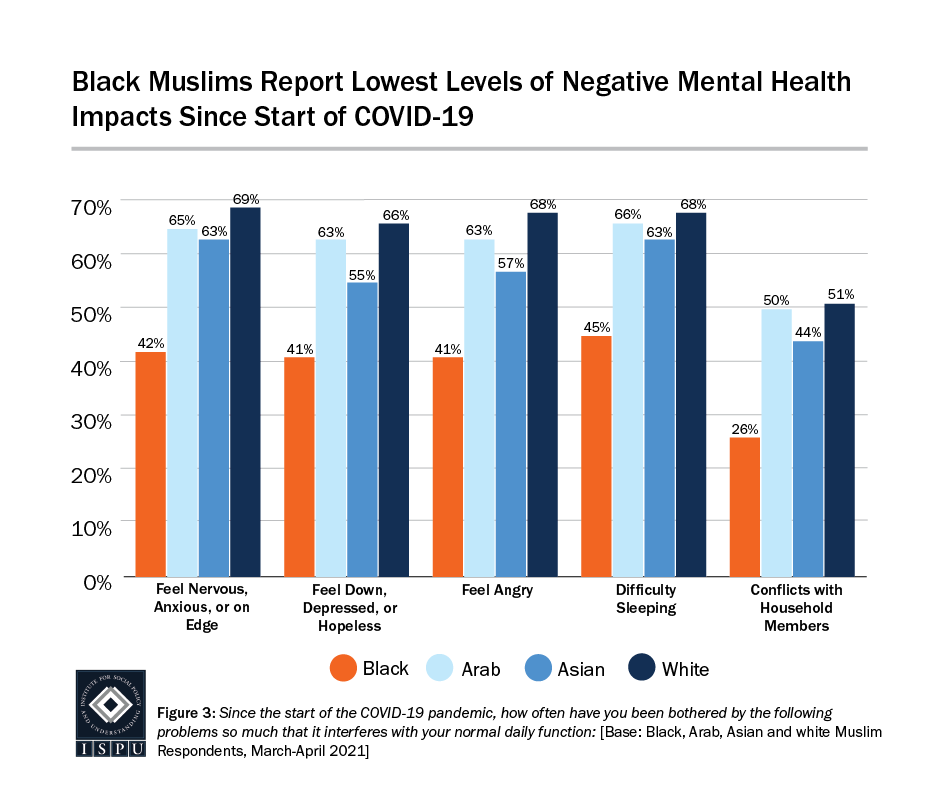
Negative Mental Health Impacts One Year into the Pandemic
November 16, 2021 | BY ERUM IKRAMULLAH
SUMMARY
American Muslims report slightly higher negative mental health impacts than the general public. Muslims aged 50 and older and Black Muslims have fared better than younger Muslims and Arab, Asian, and white Muslims, respectively.
Since March 2020, the COVID-19 pandemic has impacted nearly all aspects of American life. Our health behaviors, social interactions, shopping habits, and work, school, and home environments have all been affected. The pandemic has also had significant impacts on mental health. From the isolation of living through lockdowns and physical distancing (or the stress of managing relationships as households are spending more time together than ever before) to the fear and anxiety around the potential of becoming, or having a family member become, sick, hospitalized, or even killed by COVID-19, to the stress faced by frontline workers putting their lives at risk day after day, our minds and bodies are working overtime to process and manage all the ways our lives are affected.
The Institute for Social Policy and Understanding (ISPU) fielded a survey from March 22, 2021 – April 8, 2021 to assess American Muslims’ experiences living for one year through the COVID-19 pandemic. The survey also provided comparisons to the general population. The full survey methodology is available here. Our analysis reveals significant findings about the mental health of American Muslims during the pandemic, as well as key differences among subpopulations of the American Muslim community.

Negative Mental Health Impacts One Year into the Pandemic
November 16, 2021 | BY ERUM IKRAMULLAH
SUMMARY
American Muslims report slightly higher negative mental health impacts than the general public. Muslims aged 50 and older and Black Muslims have fared better than younger Muslims and Arab, Asian, and white Muslims, respectively.
Since March 2020, the COVID-19 pandemic has impacted nearly all aspects of American life. Our health behaviors, social interactions, shopping habits, and work, school, and home environments have all been affected. The pandemic has also had significant impacts on mental health. From the isolation of living through lockdowns and physical distancing (or the stress of managing relationships as households are spending more time together than ever before) to the fear and anxiety around the potential of becoming, or having a family member become, sick, hospitalized, or even killed by COVID-19, to the stress faced by frontline workers putting their lives at risk day after day, our minds and bodies are working overtime to process and manage all the ways our lives are affected.
The Institute for Social Policy and Understanding (ISPU) fielded a survey from March 22, 2021 – April 8, 2021 to assess American Muslims’ experiences living for one year through the COVID-19 pandemic. The survey also provided comparisons to the general population. The full survey methodology is available here. Our analysis reveals significant findings about the mental health of American Muslims during the pandemic, as well as key differences among subpopulations of the American Muslim community.
Muslims Report Slightly Higher Negative Mental Health Impacts
Overall, American Muslims were slightly more likely than the general public to face negative mental health impacts since the start of the pandemic. Muslims were slightly more likely than the general public to feel nervous, anxious, or on edge nearly everyday (11% vs. 7%); to feel down, depressed, or hopeless more than half the days or more (27% vs. 20%); and to feel angry more than half the days or more (23% vs. 15%). American Muslims were also slightly more likely than the general public to experience other impacts related to mental health, including to have some difficulty sleeping (62% vs. 56%) and increased conflicts with household members for more than half the days (20% vs. 13%).
Among Muslims, there were no gender differences in experiencing negative mental health impacts since the start of the pandemic. On the other hand, among the general public, women were more likely than men to feel nervous, anxious, or on edge for several days (40% vs. 29%); to feel down, depressed, or hopeless several days (40% vs. 29%), and slightly more likely to feel angry more than half the days (13% vs. 9%). Women in the general public are also more likely than men to experience difficulty sleeping (34% vs. 27%) and increased conflict with household members several days (25% vs. 18%).
Muslim Elders Report Fewer Mental Health Impacts
Younger Muslims were more likely than older Muslims to experience negative mental health impacts during the pandemic. Specifically, Muslims aged 18-29 and 30-49 were more likely than Muslims aged 50 and older to feel nervous, anxious, or on edge (65% and 63% vs. 44%, respectively); to feel down, depressed, or hopeless (61% among both 18-29 and 30-49 year olds vs. 42%), and to feel angry (60% among both 18-29 and 30-49 year olds vs 47%). Younger Muslims were also more likely to experience any difficulty sleeping (65% and 64% vs. 51%) and any household conflicts (46% and 42% vs. 33%). We found the same pattern when looking at age differences in mental health impacts among the general public.
Black Muslims Fare Better than Arab, Asian or White Muslims
When looking at mental health impacts by race, we find that among American Muslims, Black Muslims are least likely to report negative mental health symptoms. When it comes to feeling nervous, anxious, or on edge, 65% of Arabs, 63% of Asians, and 69% of white Muslims report any occurrence, compared with 42% of Black Muslims. Similarly, Black Muslims were least likely to feel down, depressed, or hopeless at all (41% vs. 66% of Arabs, 55% of Asians, and 66% of whites), least likely to feel angry (41% vs. 63% of Arabs, 57% of Asians, 68% of white Muslims), least likely to experience difficulty sleeping (45% vs. 66% of Arabs, 63% of Asians, and 68% of white Muslims), and least likely to experience increase household conflicts (26% vs. 50% of Arabs, 44% of Asians, and 51% of white Muslims). This pattern of racial differences is unique to the American Muslim community. Among the general public, we find that, overall, white Americans are less likely than Black and Hispanic Americans to report mental health impacts.
American Muslims, a community long thought to experience high levels of stigma around mental health disorders, may be reaching a turning point when it comes to acceptance of mental health issues. Recent research from the National Alliance on Mental Health suggests that for Americans, overall, despite the challenges of living through COVID-19, it has brought on more openness about mental health challenges.
These findings also suggest several areas where further research is needed. Specifically, we need:
-
- More data to capture if, and how, mental health challenges are evolving throughout the course and different phases of the pandemic.
- A closer look at subpopulations of Muslims, qualitatively and quantitatively, to better understand their unique stressors and thus develop solutions or therapies that cater to these groups. For example: younger Muslims.
- To understand if racial disparities in mental health struggles are correlated to different degrees of internalized stigma in different races/cultures.
- A closer look at subpopulations of Muslims, qualitatively and quantitatively, that are faring better than other groups when it comes to mental health impacts, for example, Black Muslims. Such an analysis will allow for identifying potential solutions that can be applied/tailored to other segments of the Muslim community.

Erum Ikramullah is the Research Project Manager at ISPU, where she manages the day-to-day activities of the organization’s research studies. Learn more about Erum→




